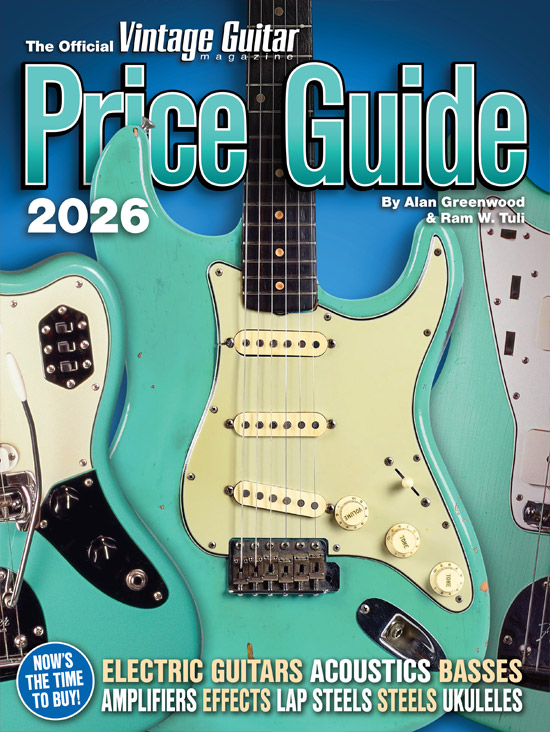Anyone who thinks ’60s Valco/National Res-O-Glas electrics look weird now ought to reflect on what the reaction might have been back then. The bodies of this bizarre lineup were molded in halves from a resin/fiberglass compound and the portions snapped into a rubber strip at the seam.
Factor in other oddball Valco doodads like “Gumby-shaped” headstocks, control knobs on the bass side of the body instead of the usual treble side, and built-into-the-bridge Silversound pickups, and you’ve got one of the strangest aggregations in the history of American electric stringed instruments.
The “map-shaped” bass in the National Res-O-Glas collection (so named because it looks vaguely like a silhouette of the U.S.) started out as the Val-Pro 85. It differed slightly from the National 85 that replaced it in several cosmetic areas; the Val-Pro had rounded cutaways, the backward flair of the pointed cutaway horns on the National gave its upper bout a slightly smaller look; the two knobs on the Val-Pro lined up at an angle to the strings (instead of parallel); and some (if not most) of the tuners on the earlier looked like a curved blade, versus the more normal-looking tuners on our specimen.
However, some of the common features of the two basses were just as unusual as their differences. Note the Gumby headstock, the quarter-circle fret markers, a fingerrest and a thumbrest, and the cloth wire at the bridge (attached to the pickup), which has all of the aesthetic appeal of a worm in an apple. The undersides of the clear plastic fingerrest, thumbrest, and bridge have a silvery, foil-like material stuck to them.
The two knobs are actually separate volume knobs for each pickup; however, the Silversound bridge unit sounds so bright and/or dinky, its volume knob serves as a tone knob of sorts, as well. Roll back on that knob, and a deeper sound is evoked; turn it up and an almost “ticking” sound can be heard anytime a string is plucked.
The scale of this bass is particularly intriguing (and woefully inadequate, considering the instrument’s sound), as it’s about 25″ – i.e., guitar-length (Gibson’s standard scale was/is 243/4″; Fender’s standard guitar scale was/is 251/2″). Accordingly, if short-scale basses (30″ to 301/2″) are considered sonically-challenged concerning their resonance when compared to full 34″-scale instruments, this one is to be avoided at all costs.
Nevertheless, the owner of this instrument insists he can get a special, retro-ish sound out of it, in spite of all its “shortcomings”… but it’s not his primary performance instrument.
This example dates from the last year of the 85’s production; its serial number (on a foil sticker) has a “1” prefix, and that serial number system (which isn’t dependable) was implemented in 1965.
Another interesting item on the back of the headstock is a decal, apparently from a music store in Demorest, Georgia, called Ralph’s. The decal has been individually stamped, perhaps manually, with “No. 14.” Demorest is a small town in the northeast section of the Peach State, and there’s no longer a phone listing for Ralph’s in that community, so the meaning of “No. 14” and any other anecdotes pertaining to this bass are probably lost in the mists of time.
And such is also the case for the Res-O-Glas series of Valco-made instruments. Too odd for their own time, the “why” of their marketing story may never be fully explained. They may command a bit of attention due to their goofy looks nowadays, but that’s about it. As for a decent bass sound… fergeddaboudit.
This article originally appeared in VG‘s Aug. ’03 issue. All copyrights are by the author and Vintage Guitar magazine. Unauthorized replication or use is strictly prohibited.



